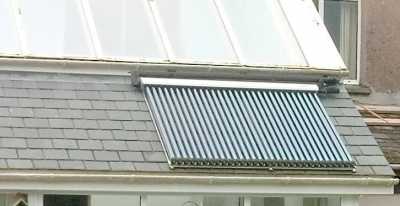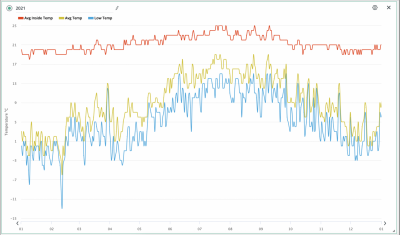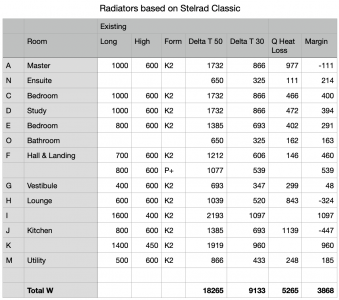ASHP Retrofit in a 2015 house with 10mm radiator tails
Our house is less than 10 years old, a 4 bed kit built, in the Heart of Scotland. We have lived here since 2019 and I have wanted to do ASHP for a couple of years but was put off initially by the "bigger pipes and radiator" brigade. Then this year I got excited by hybrid but have gone cold on that because it doesn't future proof us into older years and am now back on full HP plus solar and batteries.
Like many properties here the 2 main bedrooms are in the roof. The heating and hot water is a Worcester Bosch 42 CDi controlled with Bosch EasyControl. As far as I can see the main runs of heating pipework are in 22 and 15 with the radiator tails 10mm PEX. The ground floor pipes are buried in the insulation below the board and all the floor finishes are laminate and Karndean and aren't coming up any day soon.
At the moment we are looking at a Daikin mono bloc with a buffer and a Mixergy HW tank all with TOU as required.
My concern is that, despite all I read, the installers still suck teeth about our radiators and I seem to be doing battle with their standard MCS calc sheets. I understand their need to follow process but surely there must be some room for the actual situation. The EPC gave a floor area of 165m2 and WB suggested a heat loss of 8200w however I have done a whole envelope heat loss using the building regs drawings, generous actual dimensions, DeltaT of -5 to 25C and I get a figure of 5400w.
Last year we used 15500kwh of gas with a boiler temperature set at c.50C. For the past month we have set the whole house at 15C overnight and 20C during the day (with the odd boost in the living rooms) and gas consumption seems roughly the same as this time last year. A few months ago we repaired the builders insulation in the ceilings and added a layer of breathable quilt to the underside of the roof in all the loft spaces.
The total radiator capability of the house at 75C is 18.25kw so at 55C would be around 13.4kw which seems OK to me but I could juggle radiators and change 5 of them to get back to 18kw.
I was originally told we needed the buffer because of the radiators but in addition to that I see it as allowing us more granular control. For the most part there are only 2 of us here and we don't use every space all the time. So we would perhaps run the house at no more than 20C during the day with a degree or two boost (using the EasyControl) to the living rooms when needed.
So there you have it and I would really appreciate thoughts from you good folk.
Well that's refreshing... a new Forum Member who starts by offering lots of data for us to chew over! 😉
Firstly, I agree with your thinking about a buffer tank. If you have the space available, then you're unlikely to regret adding storage.
I don't know the weather stats for your area, but you could also consider installing a storage cylinder with additional input from a solar-thermal array mounted on the roof. They achieve around 80% efficiency, compared with 19% for a typical modern PV panel array. My 30-tube solar-thermal is working well today in Devon, despite the air temperature being 4degC.
You said in the Hello topic that your favoured installer is coming to visit next week and that he can offer the heat & insulation survey. That report will give you the heat-input required to maintain your internal temperature at 21degC, from which the size of radiators normally gets assessed.
You could ask him to also add a section to his report with the usual calculation reversed. Ie what's the water flow-temperature required if your existing radiators are used?
Once you know if the KwH (joules) required is massively different, that could assist with deciding the best way forward. Until then, all options remain on the table.
Save energy... recycle electrons!
Posted by: @transparentWhether your existing radiators are adequately sized to deliver the heat-input required for your house is probably the first question to get answered.
Indeed. A good rule of thumb is a ASHP with a highish leaving water temperature (say 50 degrees, which means a delta t (difference or delta, between water temp and room temp) of around 30) will need like for like type (same numbers of panels etc) rads that twice as large as those correctly sized for a fossil fuel system. I say correctly sized, because sometimes they are over size, but not by enough to make then usable in a ASHP system. Doubling the size of your rads is quite a big jump, I rather suspect many (I certainly didn't at the outset) don't appreciate the likely scale of the upgrades needed.
If you are not afraid of a spreadsheet, you can do the calculations yourself. The methods are well established (its physics, but don't let that put you off), and various spreadsheets including STCBN (the spreadsheet that cannot be named) are available. You sum the heat loss for the components in a room to get the loss for that room, and then sum the rooms to get the total heat loss. For the rads, you take the delta t 50 output (which is given in every catalogue) and downrate by a correction factor for the ASHP flow temps and the corresponding delta t. You end up with something like this:
Living room: heat loss 2kW, existing rad delta t 50 output = 2.2 kW, correction factor at ASHP delta t of 30 is 0.5, rad output on ASHP = 1.1kw = not enough
and so on for all the other rooms.
The total heat loss is what determines the size (power) of the heat pump you need. Be very aware the headline ratings are downright misleading. You absolutely need to know what the real output is when it matters, ie when it is cold outside. A 12kW ASHP will not produce 12kW when it is around zero outside. The information is there, but all too often buried in documents the average consumer will never see.
The great advantage of doing it yourself, apart from saving £££, is that you start to get to understand things better. That can only serve you well. You will also learn some useful stuff about where your heat goes, whether it is through windows, walls, or roof etc.
I agree very strongly with @julianc about hybrid systems, not only over complex, but also very costly and in effect likely to be the worst of both worlds. The better compromise is to be prepared to run your AHSP on the hot side, and be prepared to take the efficiency (COP) hit, or, if necessary, have a simple supplementary heating system such as a wood burner (which also has the advantage of not needing electrical power).
Testing how your rads perform with your current boiler turned down to ASHP flow temps is also an excellent idea. It is in effect a sort of empirical way of doing what the spreadsheet calculations do, and it could argued that because it is a real world experiment, its results have to be taken seriously. Strictly speaking, you will also need to get the difference between the flow and return temps to a typical ASHP difference of around 5 degrees. You will need to do it in cold weather though, almost any heating system will work in warmer weather.
Midea 14kW (for now...) ASHP heating both building and DHW
@transparent you want weather data? I can give 3 years of history and real time from a Davis VP+ station data and graphs e.g..
Solar thermal isn't an option. South facing roof is the front of the house, management won't be having that, and in any case all of the wet/heating is at the rear.
Yes I will have a better idea next week. The radiators are currently under used and we are happy to up the radiators by say 50% but the pipe size will always be the pipe size. It would costs thousands extra to replumb and we would never get near payback even if we lived to be 100.
At the moment the grants and interest free loans in Scotland for a whole HP/PV/Batt system indicate a payback in less than 10 years, hopefully a lot less then, and we can live with that.
Hi Alistair,
Welcome to the forum.
A fairly simple way of testing the capabilities of your present system would be, as previously suggested, turn down the water temperature of your present gas boiler, as low as possible.
Then record the length of time that your gas boiler is switched on, against the time it is off. Also measure the flow and return temperatures on your radiators, along with room temperatures and ambient air temperature variations.
If you have a Smart meter also record the gas consumption each time the boiler is operating.
From the above data it should be possible to assess the approximate heating demand of your home under varying conditions.
@derek-m EDF installed smart meters a year ago so I could do just that. Despite revisits the gas meter never worked and apparently won't until they come back and fit the next generation. The electric worked at the second attempt but gave up in February. However Bosch EasyControl shows me an accurate daily consumption and at a boiler temp of 40-50C and daytime outside around 6C the house easily stays at 20C without the boiler having to cut in often.
Posted by: @alistairgbarron@derek-m EDF installed smart meters a year ago so I could do just that. Despite revisits the gas meter never worked and apparently won't until they come back and fit the next generation. The electric worked at the second attempt but gave up in February. However Bosch EasyControl shows me an accurate daily consumption and at a boiler temp of 40-50C and daytime outside around 6C the house easily stays at 20C without the boiler having to cut in often.
So if you know your daily gas consumption at an average ambient temperature, you should be able to work out a rough estimate of the heating demand.
Do you know the quoted efficiency of your gas boiler?
@cathoderay so I have done as you suggest.
Heat Loss Q with a DeltaT of 30C (-5C to 25C) my whole envelope heat loss came to 5400w and room by room came to 5200W - the difference will be the width of the internal walls.
So as you suggest I have a room by room spreadsheet of radiators. I don't know the make of ours are so I used a Stelrad Classic as they look very much the like that - don't they all? Multiplying the catalogue DeltaT50 value by 0.5 to get DeltaT30 all but one room are within range and comfortably so.
The total DeltaT50 output is 18kw therefore the total DeltaT30 output would be 9kw against a heat loss of 5400w.
@alistairgbarron - sorry, I see now that you are already well ahead of the game on the calculations. I also got a bit confused by the thread/post re-arrangements.
You are right, most standard range rads are pretty much interchangeable between brands for output +/- a watt or two, though sometimes there are slight differences in off the shelf sizes available. Most of my calcs were done on KRADs, I used Stelrad conversion factors, and the actual fitted rads were Ultraheat (because that was what was in stock at the critical moment)! The delta t 50 to 30 correction factor is actually just over 0.5 (its 0.513) so you will have very marginally under-estimated output if you just divided by 2 (as it looks as though you have done). There's a full table of correction factors in single degree increments available from Stelrad (Ireland) here.
It looks to me like it's possible your entire gas system was originally massively over specced, and that has left enough slack - or should that be headroom? - in the system to mean most of your rads are OK at a delta t of 30. This is backed up by the fact you can run the gas boiler at (higher end) heat pump flow temps and still have a warm house.
Comments (with the necessary proviso that your calcs need to be right!): upstairs, the master bedroom rad is a bit too small, but the ensuite has some surplus, might well be enough, given it is an ensuite, to keep the master bedroom warm. That's upstairs sorted, almost certainly no need to change a single radiator. Downstairs, I'm not quite sure how to read the table. If, as I think may be the case, rows I and K are second (quite large) rads in the lounge and kitchen respectively, and rows H and J have the total room heat loss (and the first listed rad for the room), then the total rad output for both rooms is adequate, no changes needed downstairs at all. Others will no doubt correct me if I've got it wrong, but on the basis of your figures and my interpretation you will be fine, no rad changes needed. On that basis, it would be worth asking any installer that recommends bigger rads that you also consider worth shortlisting why they think bigger rads are necessary.
Or it may be if I have misread the table, or for some other reason, some rads may need to have a higher output. As you currently have K2s, you might see what happens (in the spreadsheet) with same L x H K3s. Swapping a same L x H K2 for a K3 is (obviously) a very simple upgrade if it does the trick, if not, depending on available space, you might be able to go for a slightly larger K3, fed off the K2 pipework, and that will do the trick. But that's only if you need more output.
The 10mm tails might mean the circulating pipe has to work a bit harder, but if the main pipe runs are 22mm where they need to be there is a good chance you will be OK. Again, this is backed up by the fact you can run the gas boiler at (higher end) heat pump flow temps and still have a warm house. This is empirical evidence, always better than any 'modelling'. It might be worth running the gas boiler at even lower flow temps (if that's possible, no gas here so I've no idea whether that's possible) and seeing what happens. If things stay warm, that means your rads and pipes are sufficient, at an even lower rad/room delta t.
There's been a lot of discussion on the forum about low loss headers, plate heat exchangers and buffers, I expect you have already found and read much of it, if not, worth having a look.
Midea 14kW (for now...) ASHP heating both building and DHW
@cathoderay the kitchen and lounge have 2 rads but 1 heat loss and all the numbers stack up.
I have 2 spreadsheets for heat loss so I am making sure they are they same. And I keep going back over calc cells to make sure they are correct so I am happy with the calculations.
The master bedroom is an easy fix to add another rad so I might do that.
It looks like we’ll be getting v.low temperatures this week, like -5C overnight, so it’s going to test the boiler now set at lower temperatures. It will be interesting as the installer is coming to do their survey on Friday.
All in all it still leaves the problem of installers being anal about MCS Excel spreadsheet data and macros vs reality. Let’s see where we get to.
- 26 Forums
- 2,417 Topics
- 54.8 K Posts
- 390 Online
- 6,096 Members
Join Us!
Worth Watching
Latest Posts
-
RE: Octopus Cosy 12 Heat Pump Regret: Incredibly Loud, Poor Heating & Constant Hum - Help!
Well done for identifying it, thats half the battle. S...
By JamesPa , 4 minutes ago
-
MLCP (Multi-Layer Composite Pipe) for ASHP
@editor nope. The info you reported was sufficient for ...
By iotum , 10 hours ago
-
RE: Advice for a novice on Mitsubishi Ecodan 6kW
@robs Quick response while I'm in stationary traffic le...
By Sheriff Fatman , 10 hours ago
-
RE: Setback savings - fact or fiction?
Maths looks right to me, my only question about this ca...
By JamesPa , 11 hours ago
-
RE: Ideal HP290 14kW ASHP - how to optimise
@jamespa I wasn’t offended at all. You are very knowled...
By Davesoa , 11 hours ago
-
RE: Experience - New Build / Complete New Heating System
@vincro I would be surprised if it is much above 5 to 6...
By ASHP-BOBBA , 11 hours ago
-
RE: Recommended home battery inverters + regulatory matters - help requested
Yes, certainly not enough could have been tested in any...
By Batpred , 12 hours ago
-
RE: Post-Traumatic Heat Pump Stress Disorder
Yes bang on and maybe I can illustrate that by way of e...
By iotum , 14 hours ago
-
-

RE: Replacing my 18 month old Hitachi Yutaki ASHP
A big thank you to @jamespa for all his efforts online ...
By trebor12345 , 16 hours ago
-

RE: GSHP WOES! Midland based engineer recommendations?
@editor It is indeed for servicing. My current service ...
By Morgan , 17 hours ago
-
RE: Sunsynk Whole House Backup Issue
Hi @lostandconfused , I agree that topic/thread is the ...
By Batpred , 18 hours ago
-
RE: Speedcomfort radiator fans
In case it helps Andrew Kuhne on openenergy monitor has...
By JamesPa , 18 hours ago
-

Things have gone quiet with you @drei. Any updates?
By Mars , 21 hours ago
-

RE: Passiv Smart Thermostat - Help & Forum Support
Thanks @tim441. Interesting timing, as Passiv are a cur...
By Mars , 23 hours ago
-
Hi everyone, I have a two year old Marlec Solar iBoos...
By Tallmarc , 1 day ago
-
RE: Please help with the settings ecodan
Are you trying to address any particular performance is...
By Sheriff Fatman , 1 day ago
-
RE: Solis inverters S6-EH1P: pros and cons and battery options
🤣 Well, I never managed to get the HA solis "...
By Batpred , 1 day ago








